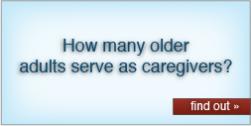Since the 1970s, Austin’s reputation as a young, active and vibrant city has drawn many new residents. And while the ongoing influx of new residents continues today, keeping our population younger than national and state averages, the folks who launched the first wave of Austin newcomers forty years ago are now moving into the ranks of “older adults.”
This range of ages in the Central Texas region—from those just testing the waters of adulthood, to adult householders raising families to older adults—is going to force us to redefine what is needed to care for this older population and how we provide that care.
1. Boomer Bubble
As the leading edge of the Baby Boomer generation (those born between 1946 and 1964) turns 65, the growth rate of the “older adult” category increases dramatically.
In the Austin-Round Rock metropolitan area, those between 55 and 64 increased 110 percent over the past decade. We have the fastest-growing population of adults aged 55 to 64 in the country and the third fastest-growing population of people 64 and older. This growth will continue for the next decade as the tail end of the boomer generation crosses the “over 55” line.
For the most part, this growth is attributable to people who have moved here for jobs and quality of life over the past forty years. A smaller portion is due to people who have retired to the area.
2. Home Sweet Home
The number one thing that older adults want is to “age in place”—to be able to stay in their own homes, living independently and autonomously for as long as possible. Aging in place is not only a less expensive option for our communities—we simply cannot afford to send everyone to an institution or a nursing home once they reach a certain level of cognitive impairment—but it also promotes the health and wellness of older adults. Sustainable aging in place, however, does require planning for a range of care assistance, from family caregivers to professional health assistance.
We know that the sooner we can work with individuals and families to understand the needs of aging adults and develop a plan for the progression of services needed as a family member ages, the better able we are to provide the services that can keep them in their homes and out of nursing homes. Those services can start with things as simple as monthly bookkeeping or housecleaning—items that get harder to do as we age, but could hold greater risk. In time, those services might increase to assistance with bathing or transportation and, potentially, to the need for in-home medical care.
There is a significant learning curve, as well as fear and anxiety, in creating a care plan. Caregivers may become overwhelmed; aging adults might fear the loss of their independence. Family Eldercare works hand-in-hand with families to help caregivers—sons, daughters or spouses—find the support they need to provide care to an aging loved one. We also help aging adults find and accept help from family or professional caregivers to allow them to stay safely in their homes and communities.
The demand for aging in place will be even greater for independent-spirited Boomers who are already demanding a menu of services from which they can choose to meet their needs.
3. It Takes a Village
Aging often increases isolation. It becomes harder for individuals to leave their houses; people may not be able to engage in the same group activities that once connected them to the community. Boomers are also more likely to live alone than previous generations due to higher divorce rates, independent lifestyles or smaller family sizes.
It’s critical for aging adults to maintain community connections for quality of life and their sense of satisfaction with life. Isolation also makes it harder for older adults to connect with the care and services they need.
We’re seeing the growth of models such as Capital City Village in Austin or the Beacon Hill Village that create either geographic or virtual communities for older adults. Capital City Village, a new program developed in Austin, and Beacon Hill Village are based on homeowner association models in which individuals pay dues to access a vetted list of service providers such as part-time caregivers, house cleaners, lawn services or any other service that might be needed.
4. A Menu of Aches and Pains
Preventive medicine, enhanced disease diagnostics and healthier behaviors are improving health and increasing life spans. As life spans extend, people are also living longer with chronic diseases including heart disease, diabetes, arthritis and hypertension. Often, older adults face multiple chronic diseases simultaneously. The presence of multiple chronic conditions complicates the care that is needed—adding additional pill and therapy regimes that can be challenging to maintain independently.
Increasingly, care for older adults will need to be able to provide care for multiple conditions in ways that maintain a sense of quality of life and allow individuals to stay connected to the homes and relationships that comfort them.
Baby Boomers are generally far more self-directed in their medical care and active in seeking health care options than previous generations. They are going to demand menus of services that will allow them to maintain their quality of life amidst the relationships and settings that comfort and sustain them.
5. Meeting Diverse Needs
As the older population grows larger, it is also increasingly diverse, reflecting increased diversity throughout the overall population. In Texas, the increasing sizes of Hispanic and Asian populations will require shifts in providing to older adults. There are additional sub-groups that will demand more flexibility in accessing care into their advancing years.
Within ethnic populations, there are different expectations for caring for parents or older adults. In the Asian culture, in particular, it is expected that aging parents will remain in the home, with families providing care. This places a particular demand on family caregivers who may not be able to keep up with the needs of their aging family member. We work with families to support caregivers and develop plans that allow for outside assistance as needed.
The GLBT community is another sub-group that requires increased flexibility in the types of services needed and provided. Many older gay or lesbian adults avoid external care for fear of prejudice or abuse.
For each of these diverse groups, we are exploring opportunities to allow older adults to age comfortably within the communities and cultures in which they are most comfortable.
Not a Minute to Spare
For each of these diverse groups, we are exploring opportunities to allow older adults to age comfortably within the communities and cultures in which they are most comfortable.
Family Eldercare’s programs are helping Central Texas create the support networks and approaches that will sustain older Texans and our communities for generations to come.











